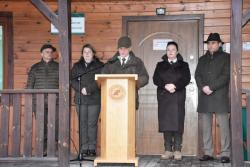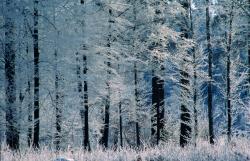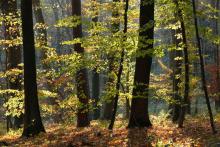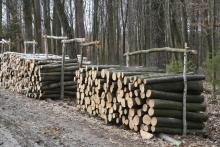 Asset Publisher
Asset Publisher
Polish forests
Poland is in the European lead, while concerning the area of all forests. They cover about 29,2 % of the country territory, and grow within the area of 9,1 million hectares. The overwhelming majority of the forests is state owned, of which almost 7,6 million hectares are managed by the State Forests National Forest Holding..
The number of Polish forest is still growing. The forestation rate of the country has increased from 21 % in 1945 to 29,2 % at the moment. Between 1995 and 2008, the forest area increased by 310 thousand ha. The basis for afforestation works is the "National Programme for Increasing the Forest Cover" (KPZL), assuming an increase of the forestation rate up to 30 % by 2020 and up to 33 % by 2050. Polish forests abound in flora, fauna and fungi. 65 % of the total number of animal species live there.
The forests grow in our country on poor soils, mainly because of the development of the agriculture in previous years. It influences the distribution of the types of the forest sites in Poland. Over 55 % of the forest areas is covered with coniferous forests. In other areas, there are forest sites, mainly the mixed ones. Their small part constitute alder and riparian forests – not more than 3 %.
In the years 1945 – 2011 the area of natural deciduous tree stands within the area of the State Forests National Forest Holding increased from 13 to 28,2 %.
Within the lowlands and uplands the most often occurring tee species is pine. It covers 64,3 % of the forest area of the State Forests National Forest Holding and 57,7 % of private and commune forests. In the mountains the predominant species is European spruce ( in the west) and European spruce with beech (in the east). Domination of pine is the result of carrying on sustainable forest management in the past. Once, the monocultures (crops or cultivations of one species) were the answer to the great demand of industry for wood. Such forests appeared to be quite fragile to climatic factors. They also were often the prey of pests' expansion.
In Polish forests, the share of other tree species, especially deciduous trees have been systematically increasing. The foresters have stepped aside from monocultures – that is why, they try to fit specific species of the forest stand to the natural stand, that would be proper for the given area. Thanks to that, in the years 1945 – 2011, the area of the deciduous tree stands within the lands of the State Forests National Forest Holding increased from 13 to 28,2 %. There occur more and more frequently the following tree species: oaks, ashes, maples, sycamore maples, elms, but also birches, beeches, alders, poplars, hornbeams, aspens, tilias and willows.
Our forests are the most often represented by the forest stands aged 40 to 80 years. The average age of the forest equals 60 years. More and more trees are of big size at the age over 80 years. Since the end of the Second World War, the forests' area has increased up to almost 1,85 million hectares.
Raport o stanie lasów w Polsce 2012
 Asset Publisher
Asset Publisher
Drewno z lubelskich lasów szczególnie cenione przez lokalnych przedsiębiorców
Drewno z lubelskich lasów szczególnie cenione przez lokalnych przedsiębiorców
 Fot. A. Brzeziecki, Nadleśnictwo Krasnystaw
Fot. A. Brzeziecki, Nadleśnictwo Krasnystaw
 Fot. M. Krysiak, Nadleśnictwo Krasnystaw
Fot. M. Krysiak, Nadleśnictwo Krasnystaw
 Fot. M. Krysiak, Nadleśnictwo Krasnystaw
Fot. M. Krysiak, Nadleśnictwo Krasnystaw
 Fot. M. Krysiak, Nadleśnictwo Krasnystaw
Fot. M. Krysiak, Nadleśnictwo Krasnystaw
 Fot. Ł. Sawczuk, Nadleśnictwo Chotyłów
Fot. Ł. Sawczuk, Nadleśnictwo Chotyłów
 Fot. A. Brzeziecki, Nadleśnictwo Krasnystaw
Fot. A. Brzeziecki, Nadleśnictwo Krasnystaw
Z najwyższą w historii ceną średnią za metr sześcienny oferowanego surowca zakończono jubileuszową piętnastą edycję Submisji Drewna Cennego „Lubelska Jesień 2024”.
Rekordowa cena wyniosła przeszło 5 163 zł i była o 436 złotych wyższa od dotychczasowej najwyższej średniej, którą lubelskim leśnikom udało się osiągnąć przed rokiem. Rozstrzygnięcie wydarzenia miało miejsce tradycyjnie przy Centrum Edukacyjno-Submisyjnym Nadleśnictwa Krasnystaw, gdzie od 12 do 18 listopada zainteresowani zakupem nabywcy mogli dokonywać oględzin wyeksponowanych kłód drewna. Najwyższą osiągniętą ceną za metr sześcienny było 10 906 złotych zaoferowane za kłodę dębową z Nadleśnictwa Chełm o łącznej miąższości 1,45 m3.
W tym roku do sprzedaży zaoferowano masę ponad 671 metrów sześciennych surowca dębowego o ponad przeciętnych cechach użytkowych. Zapotrzebowanie zainteresowanych zakupem niemal czterokrotnie przewyższało podaż dostępnego drewna. Obłożenia, z uwagi na zbyt niską zaproponowaną cenę, nie znalazły jedynie 2 losy o miąższości 1,58 metrów sześciennych.
Ostatecznie przeznaczone do sprzedaży drewno dębowe zakupiło 5 z 6 firm spełniających wszystkie wymagania ofertowe. Największych zakupów dokonali nasi lokalni przedsiębiorcy. Aż 398,68 metrów sześciennych submisyjnego surowca trafi do Lubelskiego Forniru sp. z o. o., ponad 128 metrów sześciennych zakupiła firma Wlaź sp. z o. o., a przeszło 56 metrów sześciennych udało się nabyć Firmie Teleyko.
–Cieszymy się, że wysokiej jakości drewno dębowe znalazło w tym roku tak duże uznanie w oczach polskich przedsiębiorców, czego odzwierciedleniem są wyniki jubileuszowej 15. edycji submisji organizowanej przez naszą dyrekcję – zaznacza zastępca dyrektor RDLP w Lublinie ds. ekonomicznych Robert Mąka, który podkreśla, że „Lubelska Jesień” stanowi potwierdzenie prowadzenia w naszych lasach zrównoważonej i przemyślanej gospodarki leśnej. –Surowiec pozyskany na to wydarzenie pochodzi z cięć przewidzianych w danym roku w obowiązujących planach urządzenia lasu. Submisyjne dęby, podobnie jak całość drewna pozyskiwanego w lasach lubelskiej dyrekcji, są objęte międzynarodowym certyfikatem PEFC potwierdzającym przestrzeganie zasad zrównoważonego rozwoju, zachowania trwałości lasów i ochrony przyrody.
Warto wspomnieć, że tego typu wydarzenia nazywane submisjami, podczas których nabywcy mogą zakupić egzemplarze drewna unikatowego pod względem jakości i wymiarów są organizowane w wielu krajach europejskich takich jak m.in.: Niemcy, Austria, Francja, Szwajcaria, Czechy, Słowacja, Słowenia, Belgia czy też Węgry.
–Podobne przedsięwzięcia mają już swoją renomę na rynku europejskim, od którego poziomem nie odbiegają również organizowane przez wybrane regionalne dyrekcje Lasów Państwowych submisje, w tym lubelska. Warto zauważyć, że w poprzednich latach oferowany przez nas surowiec drzewny cieszył się także uznaniem zagranicznych kontrahentów – dodaje naczelnik Wydziału Gospodarki Drewnem Justyna Janeczek-Baran. –Tak naprawdę większość osób nabywa na co dzień różnego rodzaju przedmioty wykonane z drewna sprzedawanego w drodze submisji. Z odpowiednio wyselekcjonowanego surowca o wyjątkowych parametrach technicznych i estetycznych powstają: okleina i fornir, meble, schody, elementy budowlane, a nawet instrumenty muzyczne.


 fot. Paweł Fabijański
fot. Paweł Fabijański
 fot. Paweł Fabijański
fot. Paweł Fabijański
 fot. Paweł Fabijański
fot. Paweł Fabijański





